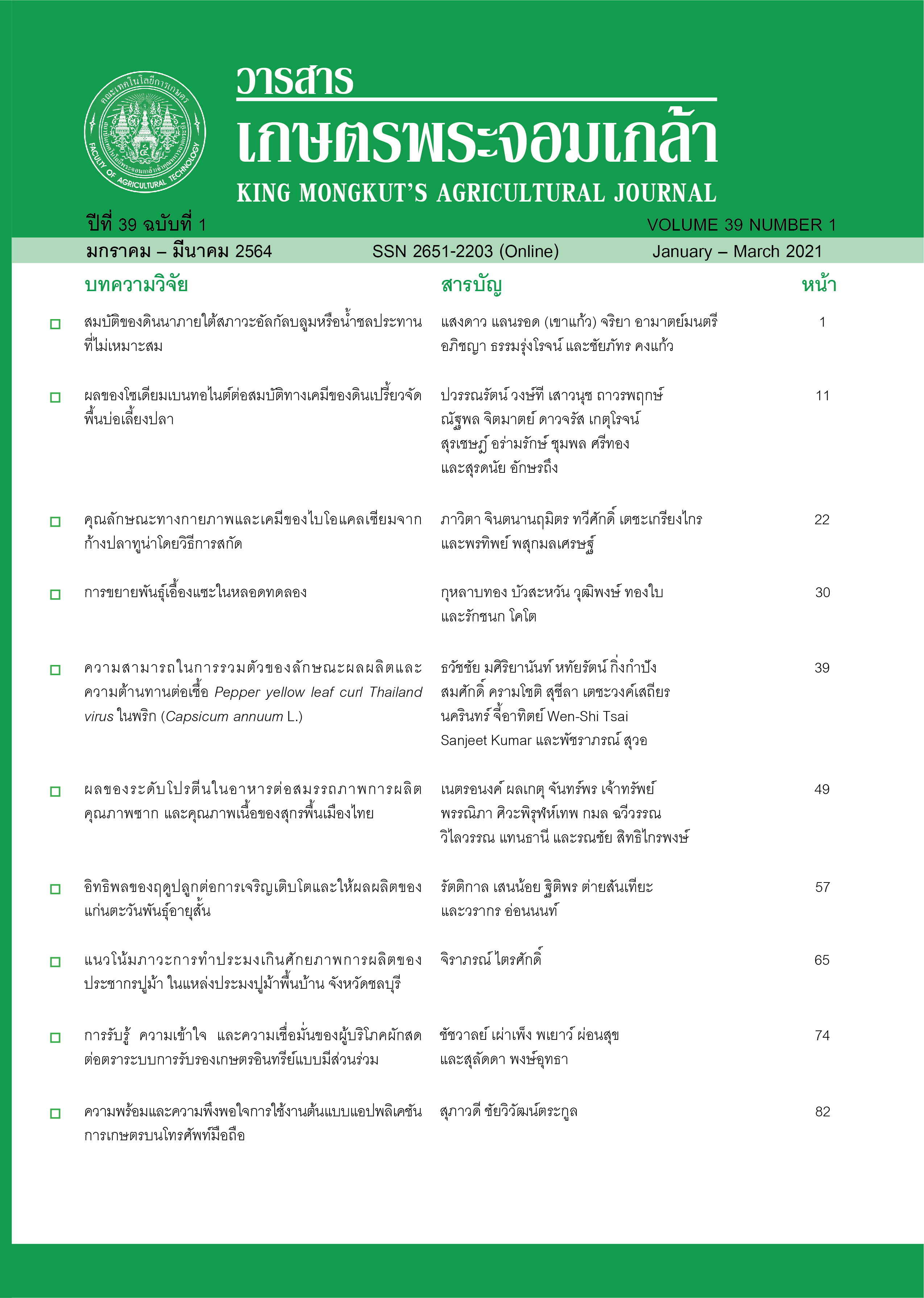สมบัติของดินนาภายใต้สภาวะอัลกัลบลูมหรือน้ำชลประทานที่ไม่เหมาะสม
Main Article Content
บทคัดย่อ
การศึกษานี้ทำการวิเคราะห์สมบัติทางเคมีของดินนาสองแปลงในเขตภาคกลาง เพื่อความเข้าใจที่ดีขึ้นถึงสาเหตุของการเจริญเติบโตที่ผิดปกติของข้าวที่ปลูกในบริเวณดังกล่าว เพื่อหาแนวทางป้องกันและแก้ไขปัญหาสำหรับการปลูกข้าวในรอบต่อ ๆ ไป โดยแปลงนาแปลงที่หนึ่งตั้งอยู่ที่อำเภอหันคา จังหวัดชัยนาท พบปัญหาสภาวะอัลกัลบลูมส่งผลให้การเจริญเติบโตและแตกกอของข้าวลดลงมาก แปลงนาแปลงที่สองตั้งอยู่ที่อำเภอเสาไห้ จังหวัดสระบุรี พบปัญหาการงอกและการเจริญเติบโตของข้าวต่ำมากในฤดูแล้งของทุกปีโดยเฉพาะในบริเวณที่พบอนุภาคสีขาวบนผิวดินจำนวนมาก แปลงนาแปลงที่หนึ่งทำการทดลองโดยเก็บตัวอย่างดินมาวิเคราะห์ค่า pH, ค่าการนำไฟฟ้า (EC), ปริมาณอินทรียวัตถุ (OM), ไนโตรเจนทั้งหมด (total-N),ความเข้มข้นทั้งหมด (total concentration) และปริมาณที่สกัดได้ (extractable concentration) ด้วยสารสกัด Mehlich-III ของธาตุฟอสฟอรัส (P), โพแทสเซียม (K), แคลเซียม (Ca), แมกนีเซียม (Mg), ทองแดง (Cu), สังกะสี (Zn), แมงกานีส (Mn) และเหล็ก (Fe) ส่วนแปลงนาแปลงที่สองเก็บตัวอย่างดิน น้ำจากแปลงนาแปลงที่สอง และน้ำจากคลองชลประทานที่เกษตรกรในแปลงที่สองใช้ในฤดูแล้ง ทำการวิเคราะห์ค่า pH, EC, ปริมาณธาตุโซเดียม (Na), K, Ca, Mg และ Fe ทั้งหมดในดินและส่วนที่ละลายน้ำได้ ผลการศึกษาแปลงที่หนึ่งพบว่าดินมีสมบัติที่เหมาะสมต่อการเกิดอัลกัลบลูม คือ pH สูง (>7) EC ต่ำกว่า 1.2 dS/m ปริมาณ OM สูง (>5%) ไนโตรเจน (รูปแอมโมเนียม) ฟอสฟอรัส เหล็กทั้งหมด และรูปที่สกัดได้ด้วยสารสกัด Mehlich-III สูงดินแปลงที่สองมีค่า pH ช่วง 4.11-6.35 ค่า EC และค่า sodium adsorption ratio (SAR) ต่ำกว่า 2 dS/m และ 13 ตามลำดับ ดังนั้นจึงไม่จัดว่าเป็นดินที่ได้รับผลกระทบจากเกลือ ส่วนน้ำพบปริมาณ Na (990 mg/L) และ Ca (1,129 mg/L) สูง ในน้ำที่เก็บจากคลองชลประทาน ค่าการนำไฟฟ้าและค่าของแข็งละลายน้ำทั้งหมดสูงถึง 7.35 dS/m และ 3,558 mg/L ตามลำดับ ดังนั้นน้ำจากคลองชลประทานจัดเป็นน้ำที่ไม่เหมาะสมต่อการเกษตร และน่าจะเป็นสาเหตุหลักที่ทำให้การเจริญเติบโตและการงอกของข้าวแปลงนาที่ 2 ผิดปกติ
Article Details
วารสารเกษตรพระจอมเกล้า
เอกสารอ้างอิง
ทัศนีย์ อัตตะนันทน์. 2550. ดินที่ใช้ปลูกข้าว. กรุงเทพฯ: ภาควิชาปฐพีวิทยา คณะเกษตร มหาวิทยาลัยเกษตรศาสตร์.
สมศรี อรุณินท์. 2539. ดินเค็มในประเทศไทย. กรุงเทพฯ: กรมพัฒนาที่ดิน.
Agricultural Bureau of South Australia Inc. n.d. Standard soil test methods & guidelines for interpretation of soil results. https://www.naturalresources.sa.gov.au/files/sharedassets/south_east/get_involved/land/140916-standard-tests-and-interpretation-guidelines-fact.pdf (3 January 2019).
AWRI. 2010. Vineyard activity guides, Measuring soil salinity. https://www.researchgate.net/profile/Prem_Baboo/post/soil_
salinity_readings_urgent/attachment/5db86b11cfe4a777d4eb4441/AS%3A819381248462854%401572367121559/download/v_activity_soil_measure.pdf (3 January 2019).
Bhattacharya, S., Rath, J., and Ray, S. 2013. Effects of pH and varying concentrations of nitrate, phosphate and iron on morphology, growth and nitrogenase activity in a soil-crust cyanobacterium Scytonema coactile montagne ex born, et flah. Phytomorphology: An International Journal of Plant Morphology 63: 101-111.
Chavez, C. 2008. Electrical conductivity or salt in the soil. USDA-NRCS. https://prod.nrcs.usda.gov/Internet/FSE_DOCUMENTS/nrcs144p2_067096.pdf (30 January 2019).
Chen, M., and Ma, L. Q. 2001. Comparison of three aqua regia digestion methods for twenty Florida soils.
Soil Science Social American Journal 65: 491-499.
Corkal, P. F. 2002. Copper treatment for dugouts. http://www1.agric.gov.ab.ca/$department/deptdocs.nsf/all/wqe11302/$FILE/
copperupdatede.pdf (30 January 2019).
Dunst, R. D., Born, S. M., Uttormark, P. D., Smith, S. A., Nichols, S. A., Peterson, J. O., Knauer, D. R., Serns, S. L., Winter, D. R., and Wirth, T. L. 1974. Survey of lake rehabilitation techniques and experiences. https://dnr.wi.gov/files/PDF/pubs/ss/SS0075.pdf (3 January 2019).
Gibson, C. E. 1972. The algicidal effect of copper on a green and a blue-green alga and some ecological implications.
Journal of Applied Ecology 9: 513-518.
Greenway, H., and Osmond, C. B. 1972. Salt responses of enzymes from species differing in salt tolerance. Plant Physiology 49: 256-259.
Hakim, M. A., Juraimi, A. S., Begum, M., Hanafi, M. M., Ismail, M. R., and Selamat, A. 2010. Effect of salt stress on germination and early seedling growth of rice (Oryza sativa L.). African Journal of Biotechnology 9(13): 1911-1918.
Hopkins, B. G., Horneck, D. A., Stevens, R. G., Ellsworth, J. W., and Sullivan, D. M. 2007. Managing Irrigation Water Quality
for crop production in the Pacific Northwest. Pacific Northwest Extension publication. https://catalog.extension.oregonstate.edu/sites/catalog/files/project/pdf/pnw597.pdf (3 January 2019).
Horne, A. J, and Goldman, C. R. 1972. Nitrogen fixation in Clear Lake, California. I. Seasonal variation and the role of heterocysts. Limnology and Oceanography 17: 678-692.
Illinois State Water Survey. 1989. Using copper sulfate to control algae in water supply impoundments https://www.isws.illinois.edu/pubdoc/MP/ISWSMP-111.pdf (3 January 2019).
Khan, M. A., and Panda, I. A. 2006. Effects of salinity on growth, water relations and ion accumulation of the subtropical perennial halophyte, Atriplex griffithii var. stocksii. Annals of Botany 85: 225-232.
Khaokaew, S., Landrot, G., and Sparks, D. L. 2016. Speciation and release kinetics of cadmium and zinc in paddy soils.
In Trace Elements in Waterlogged Soils and Sediments, J. Rinklebe, A. S. Knox, and M. Paller, eds. pp. 77-95.
Boca Raton, FL: CRC Press, Tayler & Francis Group.
Khaokaew, S., Takrattanasaran, N., Lachitavong, K., and Landrot, G. 2017. Decrease in rice production during the dry season
in a central region of Thailand: linking water, paddy soil, and rice properties. Goldschmidt 2017, August 13-18,
Paris, France.
Mehlich, A. 1984. Mehlich 3 soil test extractant: A modification of Mehlich 2 extractant. Communication in Soil Science and Plant Analysis 15(12): 1409-1416.
National Soil Survey Center. 1996. Soil survey laboratory methods manual. In Soil Survey Investigations Report No. 42, Version 3.0. Natural Conservation Service. United States Department of Agriculture. http://www.swcst.or.th/Report/cooperative/Soil%20Survey%20Lab%20Methods%20%20-%20SSIR%2042/SSIR_42_v4.pdf (2 January 2018).
Ologundudu, F., Adekunle, A. A., and Akinwale, R. 2014. Effect of salt stress on germination and growth parameters of rice
(Oryza sativa L.). Notulae Scientia Biologicae 6(2): 237-243.
Rietz, D. N., and Haynes, R. J. 2003. Effects of irrigation-induced salinity and sodicity on soil microbial activity.
Soil Biology & Biochemistry 35: 845-854.
Sink, T., Gwinn, J., Gerke, H., and House, M. 2014. Managing and controlling algae in ponds. Texas A&M AgriLife Extension Service. https://agrilifecdn.tamu.edu/fisheries/files/2013/09/Managing-and-Controlling-Algae-in-Ponds-Manual-format.pdf
(3 January 2019).
Soltania, A., Gholipoorb, M., and Zeinali, E. 2006. Seed reserve utilization and seedling growth of wheat as affected by drought and salinity. Environmental and Experimental Botany 55: 195-200.
Sumner, M. E., 1995. Sodic soils: new perspectives. In Australian Sodic Soils: Distribution, Properties and Management,
Naidu, R., Sumner, M. E., Rengasamy, P., eds. pp. 1-34. Melbourne: CSIRO.
Sunda, W. G., and Guillard, R. R. L. 1976. The relationship between cupric ion activity and the toxicity of copper to phytoplankton.
Journal of Marine Research 34: 511-529.
Walkley, A., and Black, C. A. 1934. An examination of Degtjareff method for determining soil organic matter and a proposed modification of the chroma acid titration method. Soil Science 37: 29-35.
Wang, L., Wang, X., Jin, X., Xu, J., Zhang, H., Yu, J., Sun, Q., Gao, C., and Wang, L. 2017. Analysis of algae growth mechanism and water bloom prediction under the effect of multi-affecting factor. Saudi Journal of Biological Sciences 24: 556-562.
Wurtsbaugh, W., and Horne, A. J. 1982. Effects of copper on nitrogen fixation and growth of blue-green algae in natural plankton associations. Canadian Journal of Fisheries and Aquatic Sciences 39: 1636-1641.


